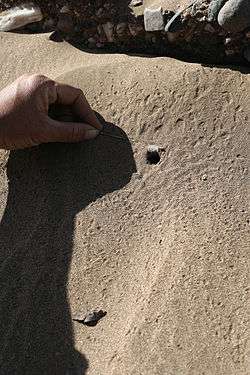Wheel spider
The wheel spider or golden wheel spider (Carparachne aureoflava), is a huntsman spider native to the Namib Desert of Southern Africa. This spider should not be confused with Leucorchestris arenicola, a spider sharing the same common name as well as the same locale.[1] The spider escapes parasitic pompilid wasps by flipping onto its side and cartwheeling down sand dunes at speeds of up to 44 turns per second.[2][3]
| Wheel spider | |
|---|---|
| Scientific classification | |
| Kingdom: | Animalia |
| Phylum: | Arthropoda |
| Subphylum: | Chelicerata |
| Class: | Arachnida |
| Order: | Araneae |
| Infraorder: | Araneomorphae |
| Family: | Sparassidae |
| Genus: | Carparachne |
| Species: | C. aureoflava |
| Binomial name | |
| Carparachne aureoflava Lawrence, 1966 | |
| Synonyms | |
| |
Characteristics
Wheel spiders are up to 20 mm in size, with males and females the same size. The wheel spider is a nocturnal, free-ranging hunter, coming out at night to prey on insects and other small invertebrates. Its bite is mildly venomous, but the spider is not known to be harmful to humans.[4]
The wheel spider does not produce a web. Its principal line of defence against predation is to bury itself in a silk-lined burrow extending 40–50 cm deep. During the process of digging its burrow, the spider can shift up to 10 litres (2.6 US gal) of sand, 80,000 times its body weight. It is during the initial stages of building a burrow that the spider is vulnerable to pompilid wasps, which will sting and paralyze the spider before planting eggs in its body. If the spider is unable to fight off a wasp, and if it is on a sloped dune, it will use its rolling speed of 1 metre per second (3.3 ft/s) to escape.[5]
References
- "Carparachne aureoflava". ZipcodeZoo.com. BayScience Foundation, Inc. 2008-08-13. Retrieved 2009-01-21.
- "The Desert is Alive". Living Desert Adventures. 2008. Retrieved 2009-01-21.
- Armstrong, S. (14 July 1990). "Fog, wind and heat - life in the Namib desert". New Scientist (1725). Retrieved 2008-10-11.
- Leroy, Astri; John Leroy (2000). Spiders of Southern Africa. Cape Town: Struik Publishers. p. 81. ISBN 1-86872-944-3.
- Mark Gardiner, ed. (April 2005). "Feature Creature" (PDF). Gobabeb Times. p. 3.
- Platnick, Norman I. (2009): The world spider catalog, version 9.5. American Museum of Natural History.
Further reading
- Henschel, J.R. (1990). "Spiders wheel to escape". South African Journal of Science. 86: 151–152. ISSN 0038-2353.
External links
- "Animal Olympians: Gymnastics" on YouTube, featuring a rolling golden wheel spider
